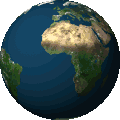|
Western
Europe 
Kingdom of Spain

Spain Lanzarote 
Arrecife
Lanzarote, a Spanish island, is the easternmost of the autonomous
Canary Islands, in the Atlantic Ocean, approximately 125 km off the coast of Africa. 
Located in the centre-west of the island is Timanfaya National Park, one of its main attractions. The island was declared a biosphere reserve by UNESCO in 1993. 
Arrecife Lanzarote Canary Islands Spain april 2024

Lanzarote is believed to have been the first Canary Island to be settled. 
The Phoenicians may have visited or settled there, though no material evidence survives. 
The first known record came from Roman author Pliny the Elderin the encyclopaedia Naturalis Historia on an expedition to the Canary Islands. 
Castle of San Gabriel. Lanzarote Arrecife, Canary Islands, Atlantic Ocean, april 2024. 
Castle of San Gabriel. Lanzarote Arrecife, Canary Islands, Atlantic Ocean, april 2024. 
Castle of San Gabriel. Lanzarote Arrecife, Canary Islands, Atlantic Ocean, april 2024. 
Castle of San Gabriel. Lanzarote Arrecife, Canary Islands, Atlantic Ocean, april 2024. 
Castle of San Gabriel. Lanzarote Arrecife, Canary Islands, Atlantic Ocean, april 2024. 
Castle of San Gabriel. Lanzarote Arrecife, Canary Islands, Atlantic Ocean, april 2024. 
Castle of San Gabriel. Lanzarote Arrecife, Canary Islands, Atlantic Ocean, april 2024. 
Castle of San Gabriel. Lanzarote Arrecife, Canary Islands, Atlantic Ocean, april 2024. 
Castle of San Gabriel. Lanzarote Arrecife, Canary Islands, Atlantic Ocean, april 2024. 
Castle of San Gabriel. Lanzarote Arrecife, Canary Islands, Atlantic Ocean, april 2024. 
Castle of San Gabriel. Lanzarote Arrecife, Canary Islands, Atlantic Ocean, april 2024. 
Castle of San Gabriel. Lanzarote Arrecife, Canary Islands, Atlantic Ocean, april 2024. 
Castle of San Gabriel. Lanzarote Arrecife, Canary Islands, Atlantic Ocean, april 2024. 
Iglesia de San Gines. Lanzarote Arrecife, Canary Islands, Atlantic Ocean, april 2024. 
Iglesia de San Gines. Lanzarote Arrecife, Canary Islands, Atlantic Ocean, april 2024. 
Iglesia de San Gines. Lanzarote Arrecife, Canary Islands, Atlantic Ocean, april 2024. 
Iglesia de San Gines. Lanzarote Arrecife, Canary Islands, Atlantic Ocean, april 2024. 
Lanzarote Arrecife, Canary Islands, Atlantic Ocean, april 2024. 
Lanzarote Arrecife, Canary Islands, Atlantic Ocean, april 2024. 
Lanzarote Arrecife, Canary Islands, Atlantic Ocean, april 2024. 
Lanzarote Arrecife, Canary Islands, Atlantic Ocean, april 2024. 
Lanzarote Arrecife, Canary Islands, Atlantic Ocean, april 2024. 
Lanzarote Arrecife, Canary Islands, Atlantic Ocean, april 2024. 
Lanzarote Canary Islands Spain december 2018

Lanzarote has a volcanic origin. It was born through fiery eruptions and has solidified lava streams as well as extravagant rock formations. 
The main road route to Playa Blanca is the LZ2, heading north from the town then eastwards to the capital Arrecife. 
Playa Blanca is overlooked by the dormant volcano Montana Roja. The walk up to and around the rim of the mountain is not too difficult and there are views over Playa Blanca, to the North of the island and across to Fuerteventura. 
Playa Blanca (Spanish for "White Beach") is the southernmost town of the Spanish island of Lanzarote. 
It is the newest resort on the island, and is part of the municipality of Yaiza. 
The residents are an eclectic mix of American, British, Canadian, Canarian, German, Irish, and Spanish. 
Lanzarote Playa Blanca, Canary Islands, Atlantic Ocean, december 2018. 
Lanzarote Playa Blanca, Canary Islands, Atlantic Ocean, december 2018. 
Lanzarote Playa Blanca, Canary Islands, Atlantic Ocean, december 2018. 
Lanzarote Playa Blanca, Canary Islands, Atlantic Ocean, december 2018. 
Lanzarote Playa Blanca, Canary Islands, Atlantic Ocean, december 2018. 
Lanzarote Playa Blanca, Canary Islands, Atlantic Ocean, december 2018. 
The coastline around Playa Blanca is essentially one large 9 kilometre wide bay which is then broken up into three smaller, but still large, bays. 
This basic geography means that the beaches in and around Playa Blanca are sheltered and ideal for swimming and sunbathing. 
The Atlantic Ocean is to the east, west and south. From the inland edge of the town to the interior, the landscape is level and volcanic. 
Lanzarote Playa Blanca, Canary Islands, Atlantic Ocean, december 2018. 
Lanzarote Playa Blanca, Canary Islands, Atlantic Ocean, december 2018. 
Lanzarote Playa Blanca, Canary Islands, Atlantic Ocean, december 2018. 
Lanzarote Playa Blanca, Canary Islands, Atlantic Ocean, december 2018. 



Lanzarote Arrecife Canary Islands Spain december 2018

Lanzarote has a marine desert climate according to the Köppen climatic classification. The little precipitation is concentrated in the winter months. 
Lanzarote Arrecife, Canary Islands, Atlantic Ocean, december 2018. 
Lanzarote Arrecife, Canary Islands, Atlantic Ocean, december 2018. 
Lanzarote Arrecife, Canary Islands, Atlantic Ocean, december 2018. 
Lanzarote Arrecife, Canary Islands, Atlantic Ocean, december 2018. 
Lanzarote Arrecife, Canary Islands, Atlantic Ocean, december 2018. 
Lanzarote Arrecife, Canary Islands, Atlantic Ocean, december 2018. 
Lanzarote Arrecife, Canary Islands, Atlantic Ocean, december 2018. 
Lanzarote Arrecife, Canary Islands, Atlantic Ocean, december 2018. 
Lanzarote Arrecife, Canary Islands, Atlantic Ocean, december 2018. 
Lanzarote Arrecife, Canary Islands, Atlantic Ocean, december 2018. 
Lanzarote Arrecife, Canary Islands, Atlantic Ocean, december 2018. 
Lanzarote Arrecife, Canary Islands, Atlantic Ocean, december 2018. 
Lanzarote Arrecife, Canary Islands, Atlantic Ocean, december 2018. 
Lanzarote Arrecife, Canary Islands, Atlantic Ocean, december 2018. 
Lanzarote Arrecife, Canary Islands, Atlantic Ocean, december 2018. 
Lanzarote Arrecife Canary Islands Spain february 2014

Arrecife is a city and municipality situated in the centre-east of Lanzarote, of which it has been the capital since 1852. 
The city owes its name to the rock reef ('Arrecife' is Spanish for 'reef') which covers the beach located in the city. 
Arrecife is also a port town serving the other islands and also Europe and mainland Africa. 
The Atlantic Ocean is to the east and southeast, the mountains are to the north, the hills lie to the west and farmlands dominate the rest of the municipality. 
The earliest records of Arrecife date from the fifteenth century when it was a small fishing settlement. PIC: feb 2014. 
Growing prosperity increased the attractiveness of the town as a pirate target: in 1571 a notorious pirate named Dogan plundered and almost completely destroyed the little port town. 
In 1964 Arrecife became the site of Lanzarote's first sea-water desalination plant, which was still operational in 2010. 
Walking around Arrecife, Lanzarote Spain, february 2014. 
Walking around Arrecife, Lanzarote Spain, february 2014. 
Lanzarote Arrecife, Canary Islands Spain, february 2014. 
Lanzarote Arrecife, Canary Islands Spain, february 2014. 
Lanzarote Arrecife, Canary Islands Spain, february 2014. 
Lanzarote Arrecife, Canary Islands Spain, february 2014. 
The name, given then as Arrecifes, refers to the black volcanic reefs behind which boats could hide, protected from sudden pirate attacks. 
Towards the end of the sixteenth century the settlement began to grow in response to a need for accommodation and warehousing to support growing trade between the old and new worlds. 
The first church was constructed at this time, consecrated to the first bishop of Arrecife, San Gines. 
Lanzarote Arrecife, Canary Islands Spain, february 2014.  
|





















